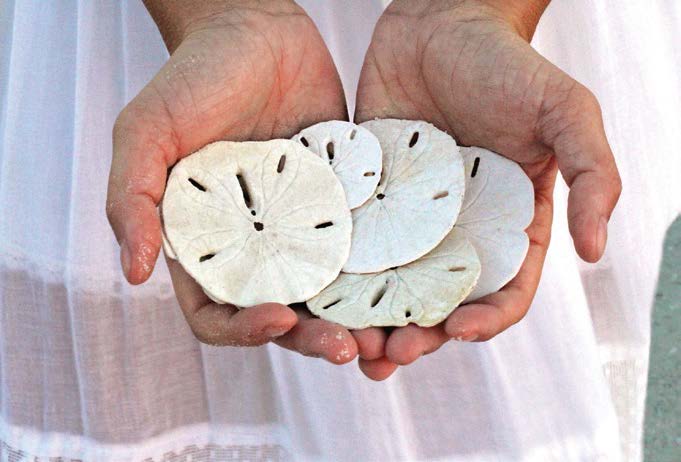
PRESERVING SPECIAL MOMENTS with souvenirs, tokens and the like is normal. Memorializing a beach trip is a bit more challenging, and signs requesting that all items be left undisturbed mean visitors depart with little save photos and their trash. Sand dollars are a different story. “The sand dollars are not a large group in the grand scheme of things, but there are over 200 species living today, and they display many strange, unique and unfamiliar features,” says Rich Mooi of the California Academy of Sciences. Related to sea urchins and starfish, sand dollars live in shallow coastal waters along the ocean floor and are usually green, purple or blue when alive. Live sand dollars are covered with a dense, velvety layer of short spines and tubular feet, which they use to burrow into the sand. They move around with their mouths toward the ground, eating microscopic particles of food, and they live for years. “Some estimates are as high as about 20 years, which is pretty old for a marine invertebrate, overall,” Mooi says. “The sand dollar living off our coast today is called Dendraster excentricus and washes up on our beaches in huge numbers after storms.” Its bleached, white skeleton is evidence of one of our commonest local offshore life forms.

Kasia Pawlowska loves words. A native of Poland, Kasia moved to the States when she was seven. The San Francisco State University creative writing graduate went on to write for publications like the San Francisco Bay Guardian and KQED Arts among others prior to joining the Marin Magazine staff. Topics Kasia has covered include travel, trends, mushroom hunting, an award-winning series on social media addiction and loads of other random things. When she’s not busy blogging or researching and writing articles, she’s either at home writing postcards and reading or going to shows. Recently, Kasia has been trying to branch out and diversify, ie: use different emojis. Her quest for the perfect chip is never-ending.


